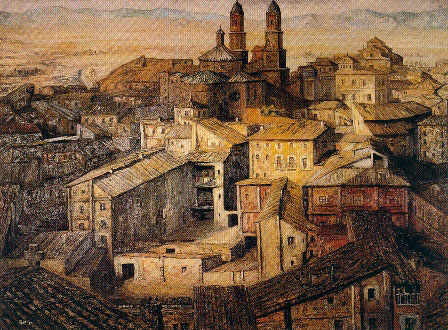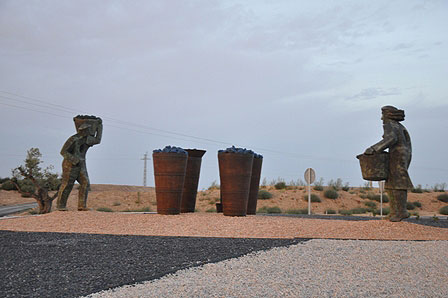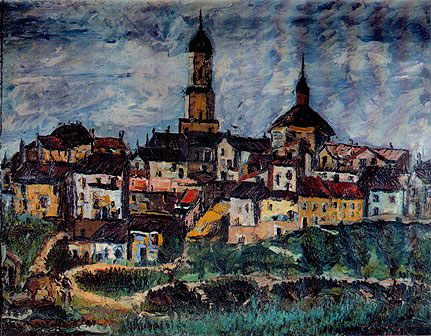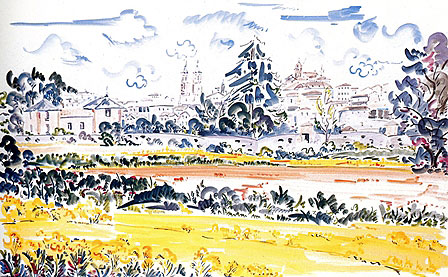BRINGING HERITAGE CLOSER. CORELLA
26 August 2010
A look at architecture and the arts in Corella in the 19th and 20th centuries
Mr. Javier Azanza López. Chairof Navarrese Heritage and Art
Despite the markedly Baroque character of the plastic arts in Corella, the artistic manifestations of the 19th and 20th centuries have also left their mark on the town.
A watercolour by the Diputación engineer Aniceto Lagarde in the mid-19th century sampleshows a view of the town, in which its architecture is in keeping with tradition, as can be seen in his placede toros (1845-47), in the Bodegas de Camilo Castilla (1856), decorated with glazed ceramics from the Sevillian factory of Manuel Ramos Rejano, or in the towers of San Miguel (1898-1900), which, according to projectby Elías Ballespín, try to harmonise with the Baroque language of the church. But at the same time, Corella timidly joined the modernity of the new materials with the construction of the iron bridge over the river Alhama (1900), which was replaced in 1963 by a new infrastructure designed by Eduardo Torroja.
In the 20th century, the figure of José Luis Arrese was fundamental for Corella, to whom the Town Council showed its gratitude by erecting a bronze bust in 1951 by the Valencian sculptor Ignacio Pinazo Martínez. Arrese's work in the field of the plastic arts is of great interest for two reasons. Firstly, because of the artists he brought to Corella to carry out various works, most of them related to the remodelling of San Miguel; this is the case of the painters Ceferino Cabañas and Jacinto Alcántara, and the sculptor Antonio Arenas. The architect and politician from Bilbao was also responsible for the presence in Corella of the singular painter Antonio Fernández Soler, who specialised in portraits and still lifes executed with an impressionist technique, and who also decorated the dome of the Convent of Araceli with religious scenes. The second was the creation in 1950 of the School of Applied Arts and Artistic Crafts in Corella, where artists such as Antonio Vaquero, José María Ascunce, Antonio Sanz Gallego and Rafael Huerta taught teaching. True to his vocation as a landscape painter, Ascunce produced an exceptional view of Corella, with a solid structure and austere colouring, which he endowed with great vigour staff. Rafael Huerta left his mark on sculptures such as the Sacred Heart of the high schoolde Pasionistas, or the monument to Marguerite de L'Aigle, which refers to the history of the place in the 12th century. Numerous artists have passed through the classrooms of the School of Arts and Crafts, including Ignacio Guelbenzu, Nuria Martínez, Beatriz Alvero "Pía" and Jesús Pérez Marín "Bóregan", author of the Monument to Peace (1990) and the Homage to the Grape Harvest (2010).

José María Ascunce. View of Corella

Boregan. Tribute to the grape harvest
From the middle of the 20th century to the present day, there are numerous artists who, for one reason or another, seem to be linked to Corella. This is the case of Pedro Lozano de Sotés and Francis Bartolozzi, who carried out the mural decoration of the Casa-Cuna (1954), with its cheerful children's invoice. Painters such as Jesús-Erich Degner Piquer (Hamburg, 1940-Madrid, 1979), a German from a Corellan family who feels the influence of his masters Benjamín Palencia and Daniel Vázquez Díaz in his Corellan landscapes of great chromatic intensity, or in his portraits of unquestionable psychological capture; Ana Mari Marín, with a watercolour of careful and joyful chromatic range; or Jesús Lasterra, who through his engravings brings us closer to the Corellan Holy Week. Urban sculpture also makes an appearance in its streets, with José Antonio Eslava's homage to Alonso López de Corella (2000), which admirably condenses the values of Renaissance art and humanism; or with the large vine leaf (2008) with which Juajo Novella raises a transparent tower-atalaya. And halfway between architecture and sculpture is Manuel Contreras' ensemble in memory of the disappeared convent of La Merced. It is precisely architecture that takes on an importance in this period, with works ranging from the construction of the Casa Sindical (José Luis Arrese, now the Centro de Creación Joven) and the high school-Noviciado de los Pasionistas in the 1950-60s, to more recent projects designed by architects such as the sports centerMiguel Induráin (1991), the Fundación María Díaz del Villar (1995, Juan Irigaray and Luciano Torres), or the Ciudad Deportiva de Corella (Antonio Vaillo and Juan Luis Irigaray).

Jesús-Erich Degner Piquer. View of Corella

Ana María Marín. View of Corella
PROGRAM
Tuesday, 24th August
Milestones in the History of Corella
D. Esteban Orta Rubio. Society of Historical Studies of Navarre
Writers and publicists of Baroque Corella
Mr. Javier Itúrbide Díaz. Uned of Tudela
Corella in the culture and art of the Baroque period
D. Ricardo Fernández Gracia. Chair of Heritage and Art of Navarre
Wednesday, 25th August
The hidden Corella. Behind the lattices of the city's enclosures
D. Ricardo Fernández Gracia. Chair of Navarrese Heritage and Art
The sumptuary arts: at the service of the splendour of worship and the Liturgy
D. Ignacio Miguéliz Valcarlos. Chair of Navarrese Heritage and Art
The festive calendar
D. Francisco J. Alfaro Pérez. University of Zaragoza
visit to the church of San Miguel
visit to the tunnels
Thursday, 26th August
A look at architecture and the arts in Corella in the 19th and 20th centuries
José Javier Azanza López. Chair of Navarrese Heritage and Art
The image of the Rosary and Saint Michael in the arts
Ms. Mª Gabriela Torres Olleta. GRISO. University of Navarra
Corella, conventual and palatial city: visit guided tour
Ms. Pilar Andueza Unanua. Chair of Navarrese Heritage and Art
Closing

